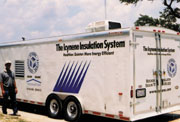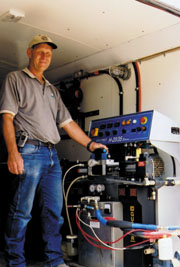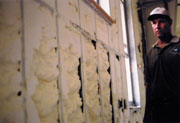


Say it and spray it
After remodeling houses for years, Beicker got into the burgeoning spray business about a year ago. Looking for an alternative to fiberglass, Beicker, based in Seguin, Texas, went into business applying expanding foam insulation because of its mold resistance. A growing number of schools, homes and offices in Texas are besieged with mold problems.When he first started, Beicker considered assembling his own multiple-component spray system. Instead, he decided on a mobile spray rig, because of its all-in-one set up and a fear his lack of spray rig experience would lead to mistakes on the job and delays. Beicker uses a Mobile Spray Rig, manufactured by Gusmer.
“I could have tried to get it together on my own,” he says, “but there’s something I might miss. Then I’m out on a job running around trying to find stuff and I’ve got guys standing around doing nothing. With the mobile spray rig, there’s little down time if something goes wrong. It’s all here.”
The entire system fits into a trailer that Beicker says he can pull at speeds up to 70 mph with his 1-ton pickup truck. The spray rig trailer contains three compartments. The first compartment is a ventilated utility room that contains the system’s diesel generator, which cranks up to 125 amps into a 24-circuit Square D electrical panel, the diesel fuel tank and the air compressor, with its 30-gallon reservoir tank. The front of the trailer also holds an equipment storage and spare tire area.
The work area—replete with heat and air conditioning units, work bench, vice, cabinets and space for chemical storage—comprises the back half of the trailer. The spray gun is self cleaning and combines chemicals simultaneously at the tip.
Self contained
Work at the 96,000-square-foot school in Dripping Springs began in May after mold was found in the walls. Joeris General Contractors, which is handling the project, called Beicker in June. The mobility of the spray rig was important for this job, Beicker says, allowing him to easily access the massive elementary school’s every wing by backing the trailer to the edge of the building, unfurling 150 feet of hose and spraying the insulation, which after combining at the gun’s tip, comes out in liquid form and expands in six to eight seconds. The rig’s internal heaters keep the chemicals at the right temperature, meaning Beicker never wastes time in the morning warming them up.“Everything is self contained,” Beicker adds. “You don’t have to go looking for electricity or air—it’s all right there.” W&C


